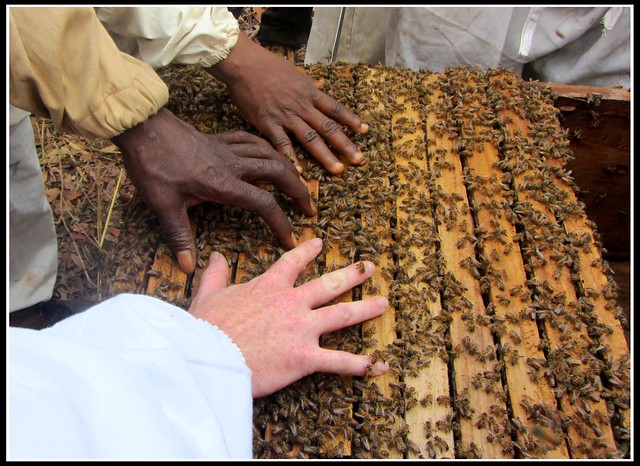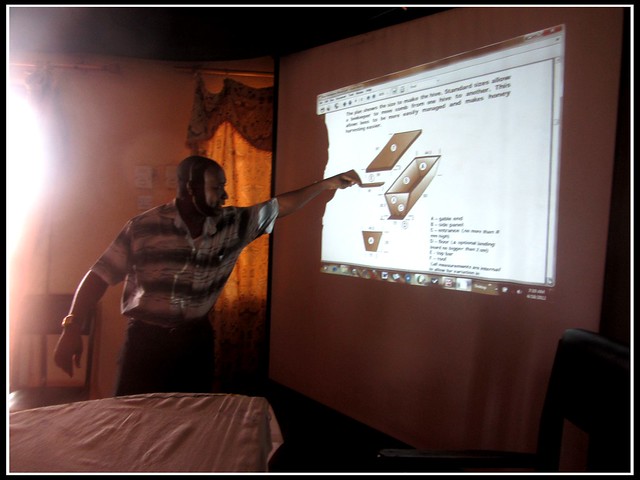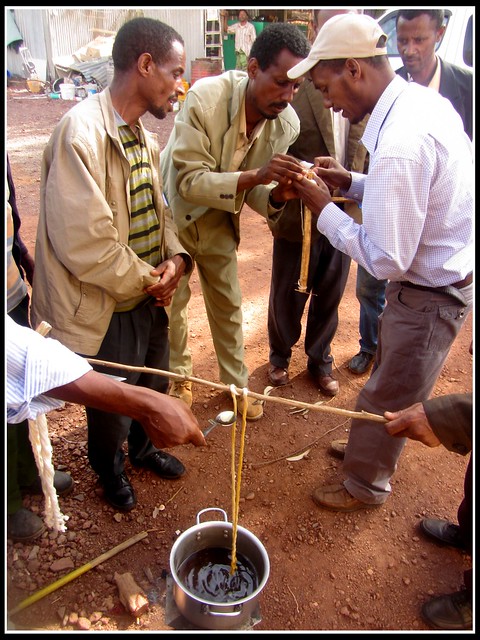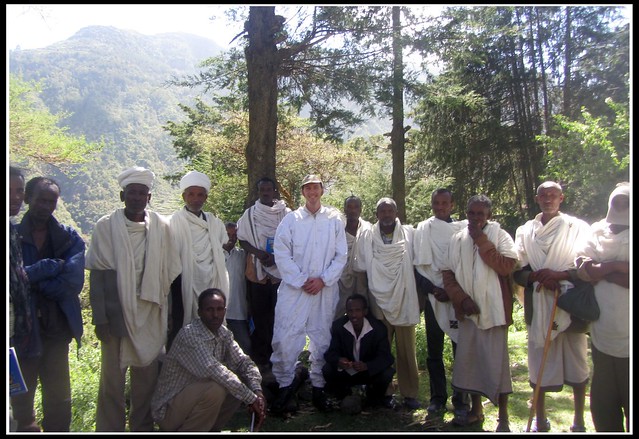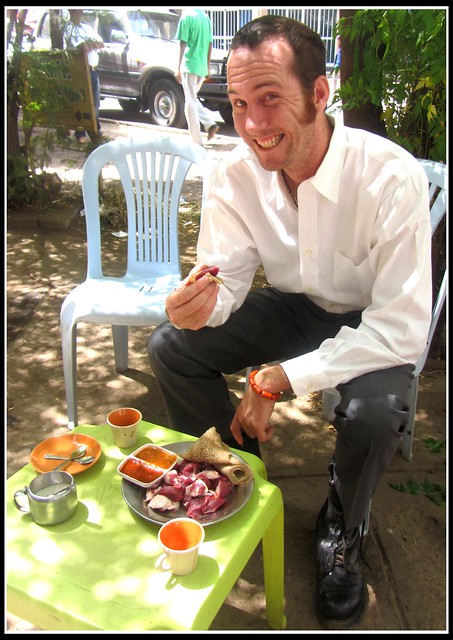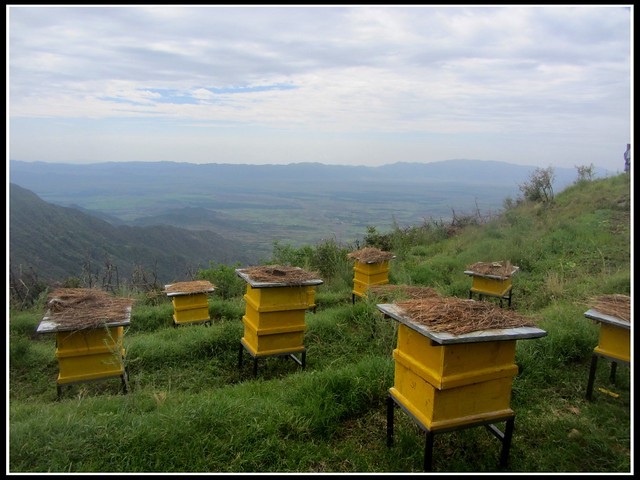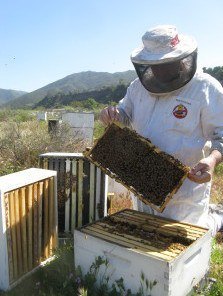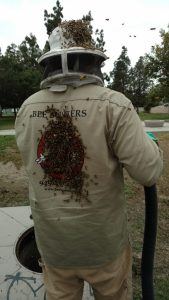Bee Busters has always believed in giving back to the beekeeping community. Company president David Marder does countless presentation to school, community, and all variety of other groups (always free), and he and other company members have always been very involved in the local Orange County Beekeepers Association. In 2012 Bee Busters was busy with the international community service!
Head Beekeeper Kris Fricke took some time off during the slow season to travel to Africa to help train beekeepers there.
The organization Winrock International organized the logistics and on-the-ground support while much of the funding came from the USAID farmer-to-farmer program. Bee Busters, in addition to supplying Kris himself, has donated several hundred dollars as well in the form of bee suits and other equipment.
In 2012 Kris did projects in Ibadan in south-west Nigeria, Nasarawa in central Nigeria, the Amhara region in Western Ethiopia, and the Tigray region in Northern Ethiopia. In 2013 we worked in “Sakiland” in Nigeria and up and down the Nile in Egypt. In 2014, next month (as of this writing in May of 2014) we’ll be sending Kris to Guinea in West Africa. But there’s so much to say about each one of these projects we’ll keep this page about 2012 and have to create another page for each year.
Beekeeping is of a lot of interest to development agencies because with very low input costs farmers can produce a valuable product. It is more than sustainable — it not only doesn’t degrade the environment in any way, but in fact helps the environment and neighboring farms through pollination.
In most places there are already traditional methods of beekeeping, but their productivity can be substantially improved through modern beekeeping methods. In the case of Nigeria, they traditionally construct hives out of hollowed out logs. They put boards or corrugated metal or whatever is at hand across the two ends, hoist it to the top of a tree (bees are more likely to move into a home that’s elevated), wait, and during harvest season they climb up there at night, kill the bees, and harvest everything in the hive!
Without getting into beekeeping details, let me tell you, this method can be improved upon.
In the photo above you can see we’re working on a hive in which the top can be removed and the honeycomb is attached to removable “topbars.” This allows for much better bee management in a wide variety of ways. Also, since they don’t work with their bees much, even the beekeepers weren’t terribly comfortable around their bees and were at first shocked when Kris took off his glove and placed it among the bees. After a short time though, they saw he wasn’t getting stung and several followed suit — that’s what I call a hands-on lesson!
The dimensions of a topbar hive need to be very exact, so in addition to showing them diagrams, Kris had them construct one out of cardboard — not a sturdy enough material for a working beehive but it was a good exercise in measuring the correct dimensions and putting it together.
Many people have asked, “do they have Africanized bees in Africa?” Well, the answer is “of course not!” They don’t have Africanized bees in Africa, they have African bees in Africa. This is actually a very important difference, because the hybrid bees are said to be much worse than either purebred bee. Nevertheless they can get mad as well, and the above picture illustrates the fact that bees (of any of the subspecies) are more likely to sting darker colors than lighter colors (ever wonder why beekeeping suits are always white?) — you can see they homed in on the Bee Busters logo like a dartboard.
Wax is often an under-appreciated hive byproduct. Frequently it is just discarded! So Kris taught them how to make candles (they cleverly came up with sections of papaya stalk as a great candle mold!), as well as lotion/body-cream making and general wax processing.
In Ethiopia (pictured above) they had their own traditional method of making candles — by dipping strands of wool in wax repeatedly they make the candles traditionally used by the Ethiopian church.
We also talked about mead making. In Ethiopia they have a very long tradition of making a mead with hops, which they call tej (pictured above). Even on this subject though, Kris, who happens to an avid hobbyist homebrewer (like many of us at Bee Busters actually) was able to offer the Ethiopians some tips (racking for clarity and how to make a simple “ventilation lock” to vent excess carbon dioxide from fermentation).
Here’s a group of beekeepers in Nigeria. I loved the outfit of the guy on the left. Here’s how he inspects bees:
And here’s a picture of some of the Ethiopian Beekeepers:
As you can see, parts of Ethiopia are actually quite forested, and much of the country is actually pretty mountainous.
Food could be interesting. In Ethiopia they commonly eat RAW MEAT. Kris, having probably an under-developed sense of personal safety, gave it a try, and so far has not reported any horrible parasite infections. We’ll have him on zombie watch for awhile though.
And this looks a lot like those giant snails…
A snake slithered out of a beehive in Nigeria. Crikey!
And there was a monkey (/baboon?) in a bee yard in Ethiopia!! Kris was unable to grab it by the tail, however.
Beehives with a view!! These hives look out over the Great Rift Valley. Off to the left a waterfall cascades down the cliff face.
Village children in Ethiopia, many of whom are the children of beekeepers who will benefit from this training.
Many many more pictures can be found here:
Nigeria I (Ibadan)
Nigeria II (Nasarawa)
Nigeria III (Sakiland)
Ethiopia I
Egypt


